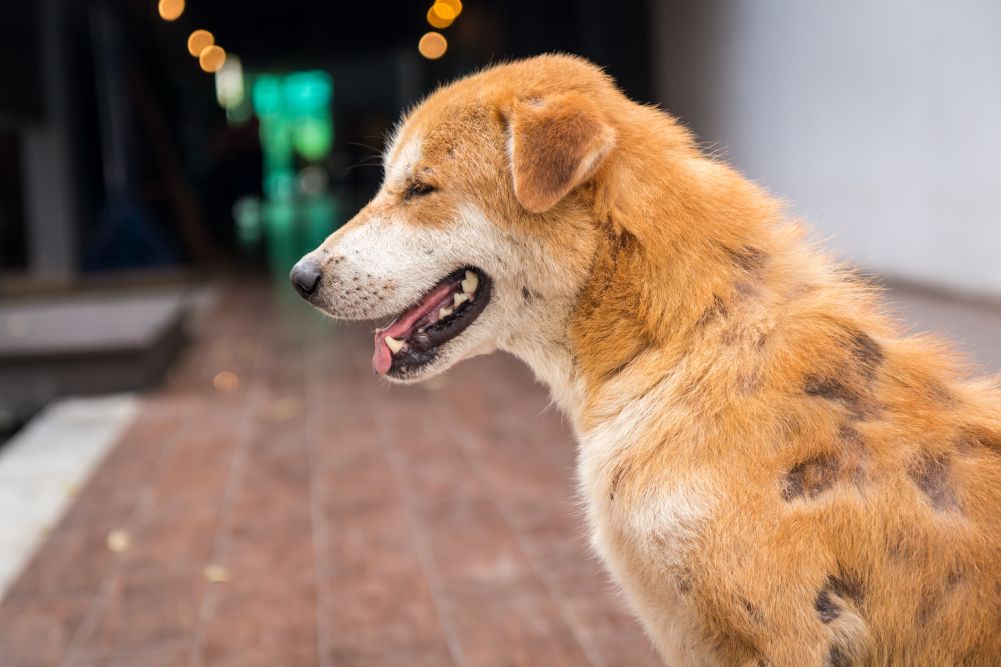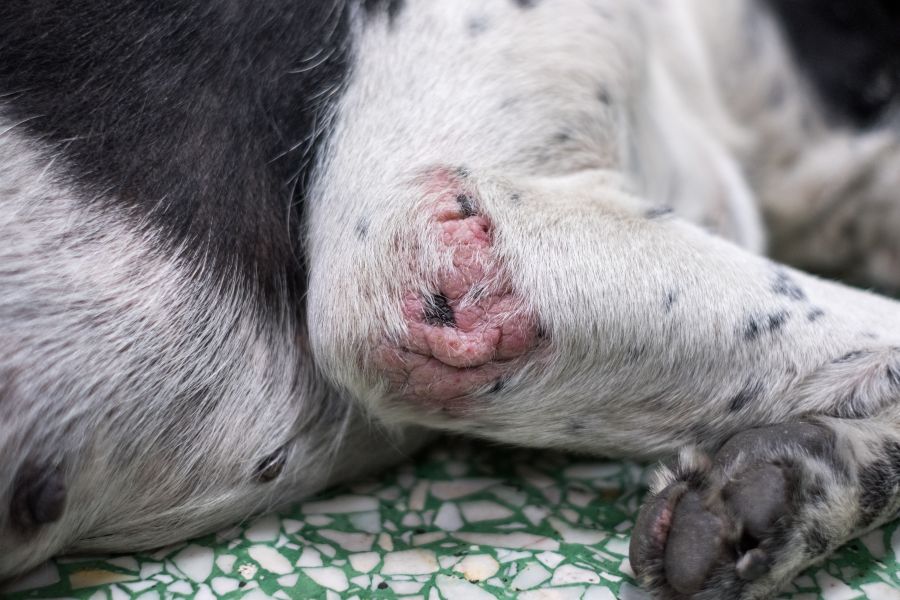What to do when your dog has crusty scabs on his body? Have you found scabs on your dog? Are they white, black, dry, or crusty?
Let us explore the causes of scabs in dogs and what you can do to get rid of them.
The Life Hype is reader-supported. When you buy through links on our site, we may earn a small commission, at no cost to you.
Table of Contents
What are Scabs?

A protective dry crusty layer formed on the wounded skin during the time of healing is called Scabs. The causes may be different. However, the size, characteristics, and the number will solely depend on the cause. After the root cause is analyzed, the vet will prescribe the treatment.
What Causes Scabs on dogs?
They can be hereditary, parasites, environmental or simple contact allergies. They may appear at specific points or all over the dog’s body. Let us look at the causes for Scabs.
Parasites
Parasites can include mites, fleas, lice, gnats, and chiggers on dogs. It becomes worst when these parasites lay eggs on the dog’s skin. This results in licking, scratching, and biting, which will eventually lead to forming scabs. This will keep increasing when the dog scratches to get relief.
Over-Grooming
Bathing your dog is definitely a good thing, but if it is overdone with the wrong products, your dog might suffer from scabs. Excessive bathing can lead to loss of natural oils from the dog’s body.
Initially, it starts with flaking and itching and later leads to scabs. Always ensure the usage of mild shampoos for your dogs.
Allergies
Inflammation and irritation can be initial symptoms of contact allergies. These symptoms are followed by bumps on the skin, licking, biting, and scratching.
Knowing the allergy’s root cause and eliminating it is the best way to eliminate contact allergies.
Poor Nutrition
Nutritional deficiency can lead to illness in our dogs. The lack of vitamins and minerals as a defense against parasites causes lumps with scabs in the later stage.
Scabs on Dog’s Back
Having Scabs on the dog’s back is a common condition and can be caused by any of the reasons mentioned above.
These scabs may be black or white, depending upon the cause and condition.
Fleas are common, especially if it is followed by itching. A good bath along with topical treatment of fleas will help in this situation.
In a few severe cases, the dog starts to shred his hair. At this point, immediately consult a vet.
Scabs on Belly and Legs
During the warm months of the year, it is common for scabs to occur on a dog’s belly and legs. The most common for this is a superficial bacterial infection because of overgrowing staph bacteria.
Black Scabs on Ears
This can be an indication of infection that requires thorough antibiotic treatment. In other cases, it can be because of sarcoptic mange, which is a microscopic mite invisible to our naked eye.
Itching is the first symptom leading the skin to become red and scaly—these mites primarily infection the hairless part of your dog’s body.
Crusty Scabs
When you find crusty scabs on a dog’s head and neck, it can be caused by pyoderma. This is a bacterial infection that needs oral antibiotics to clear off infection. These initially form as bumps filled with pus and later forming into crusty scabs.
Scabs on Nose, Snout, or Tail
A crusty and dry dog nose or snout along with nasal flaking is an indicative 9f severe sunburn. Scabs that form on the tail can be because of bacterial infection. You might also find fluid-filled blisters in the affected areas.

Prevention of Crusty Scabs
Prevention is always better than cure. Follow these preventive measures to help your pooch from developing crusty scabs.
- Examine your dog closely, every three times a week.
- Take your dog to a veterinarian twice a month.
- Maintain a balanced diet, making sure that the dog is getting enough vitamins and minerals.
Treating the Scabs
When dogs develop scabs, they might definitely bite it, and this will result in its enlargement. This is supposed to be stopped not to worsen the situation.
Knowing the root cause of the scabs will help in its treatment. Let us look at some of the treatment measures.
- Identify the scabs’ cause and closely look at their characteristics, such as whether they are white or black, crusty or dry.
- If the dog scabs are caused by something that you can treat at home, then trim the hair around the scabs. This will encourage air circulation at the affected area, dry out the scabs, and not allow the bacteria to grow more.
- To remove the dirt from your dog, give them a bath with mild and hypoallergenic shampoo. This hypoallergenic shampoo by Veterinary Formula will help in relief from itching temporarily and prevent further scabbing.
- You can use a cold compress to cool the affected area and get rid of any swelling around the area. Try this cute ice pack from Amazon.
Types of Dog Allergies
Let us now look into what are the different types of dog Allergies.
Food Allergies
This type of food allergy might develop at any point in time in a dog’s lifespan. They are mostly allergic to proteins and carbohydrates. This allergy is different from food intolerance.
Before treating this allergy, an allergy test is conducted to examine exactly what they are allergic to. Once this is revealed, you can follow a homemade diet plan which is hypoallergenic.
Common Food Allergies:
Food allergies are an immune response. The below-mentioned foods are the most common causes of food allergies in dogs.
- Wheat
- Corn
- Soy
- Yeast
- Yeast
- Eggs
- Chicken
- Lamb
- Beef
- Dairy products
To keep your dog healthy and fit, avoid that food to which it is allergic.
Airborne Allergies
Airborne allergies are also referred to as Atopy. It often occurs when your dog inhales and develops allergies. These are mostly seasonal and environmental.
It can include weeds, pollen, molds, mildew, and mites. This results in severe itching. Make sure the dog is away from these things to prevent the occurrence of the allergy.
Contact Allergies
Dogs get allergies to the things which it comes in contact with. This can be lawn chemicals, plastic, detergents, fabrics, etc. It is essential to identify and eliminate the allergen to prevent this type of allergy.
Flea Allergies
This is a common allergy. Dogs get irritated with a single flea bite and tend to lick and bite, which results in the breaking of the skin. Effective flea control is the best way to eliminate this allergy by using home treatment or flea medicines.
Allergy Symptoms
- Constant scratching might lead to a loss in the hair in the infected area and might become an open wound.
- Licking and biting the infected areas.
- Itching may cause the dog to rub its body against the wall or any hard surface.
- A running nose, sneezing and change of eyes to red color and also watering of eyes.
- Diarrhea and vomiting in cases of food allergies.
- Discoloration of hair around the paw area.
How to Control Fleas on Dogs?
If you think your dog is suffering from flea allergies, make sure you comb their coat at least once a day. Do this on a light-colored cloth to examine what kind of dirt is removed from the body.
You might find some flea feces, take these feces and dissolve in rubbing alcohol or water, and if you find red color being released, then be sure that it is blood and is an infestation by fleas.
To get rid of these, give your pooch bath regularly to relieve itching and make them feel more comfortable. Use natural products to ensure that you keep the insects at bay, especially during the flea season.
Allergy Testing
In most cases, it is essential to conduct an allergy test to examine the dog and find out the root cause to treat it. Talk to your veterinarian, and they might provide you the best allergy testing that is most suitable for your dog.
Home Remedies for Allergies
We have handpicked a few best home remedies to treat your dog’s allergies.
- Minimize the exposure of your dogs to allergens.
- Provide them a natural diet which all the ingredients and nutrients that are required. Add fatty acids to give it the advantage of being anti-inflammatory.
- To prevent plastic allergies, use glass or stainless steel dishes for your dog and ensure they are clean all the time.
- Employ flea preventive measures with only natural products.
- Wash the bedding with hot water and hypoallergenic detergent.
Final Word
Your dog might not understand that you are trying to help and might not be willing to participate. However, be more calm and patient, understand that they take behavioral cues from their owner.
Talk in a soothing tone to reassure them. These scabs are inevitably part of a dog’s life, especially if the dog is young, active, and loves to spend more time outdoors.
Just use these tips to help them heal scabs on your dog, and he’ll be the usual active dog like ever before.